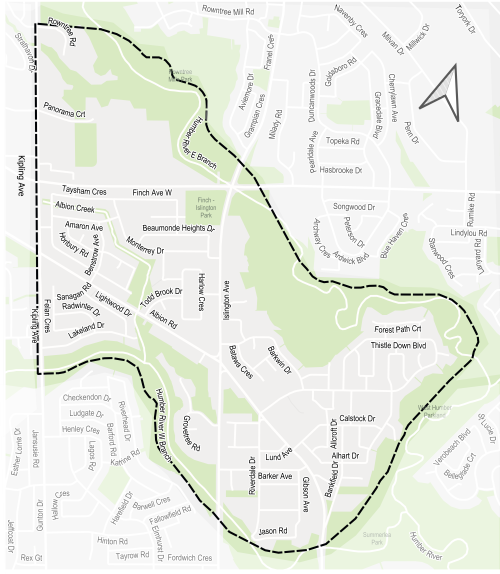
The City is developing a Neighbourhood Streets Plan (NSP) for the Thistletown area that identifies, prioritizes and recommends short and long-term improvements to traffic operations and road design to support safety for all modes of transportation.
The Thistletown Streets Plan aims to address four main areas of concern:
Public feedback, along with technical considerations and City policies and guidelines will be considered in decisions to be made by staff and City Council.
The project area is located between Kipling Avenue to the west, and bounded by Humber River to the north, south and east.

Public Consultation will take place over two phases. Phase 1 was held from April to June 2025. Phase 2 is expected to take place in Winter 2026.
Information, reference materials, and reports on public consultation activities will be posted here.
A public event was hosted on May 28, 2025 to share information on project background and to receive feedback on issues commonly experienced in the neighborhood and ideas for actions and changes.
View the public event materials below:
The Thistletown neighbourhood was nominated for a Neighbourhood Streets Plan (NSP) by the Ward 1 Councillor in the 2024 NSP program cycle. Details of the nomination process can be found on the Neighbourhood Streets Plan web page.
Neighbourhood Streets Plans (NSPs) are a service for neighbourhoods where traffic and travel patterns challenge the safety and mobility of people using the streets. Through the NSP process, a team of City staff will work with communities to identify local issues and opportunities, prioritize the greatest needs, and recommend changes to traffic operations and street designs.
NSPs consider the needs of all road users and emphasize the safety of vulnerable road users such as seniors, school children, and pedestrians, and people cycling.
There are several steps to develop a Neighbourhood Streets Plan (NSP). Through the planning process, a team of City staff work with communities to identify local issues and opportunities, prioritize the greatest needs, and recommend changes to traffic operations and street designs.
NSPs follow several steps outlined below, and public consultation takes place in two stages.
NSPs result in short-term actions (one to two years) which can be made using temporary, flexible materials like signs, paint, and bollards, and will identify longer-term changes which can be accomplished alongside future programmed road work.
The outcomes of each NSP will be different based on local conditions and the needs of each neighbourhood. Generally, NSPs will recommend actions related to motor vehicle speed and volume management, and traffic safety conflicts on local streets. NSP recommendations are informed by the City’s Traffic Calming Guide, Vision Zero Action Plan, and Complete Streets Guidelines.
The project team will keep local residents and businesses informed at key project milestones. Your information will be kept private and will only be used to notify you about this project.
To receive project updates by email, please contact us and indicate that you would like to be added to the mailing list.
Personal information is collected under the authority of the City of Toronto Act, 2006. The information is used to allow the City to send you emails about project updates and future consultation opportunities. Questions about this collection may be directed to the Manager, Public Consultation at 416-392-2990 or tracy.manolakakis@toronto.ca.